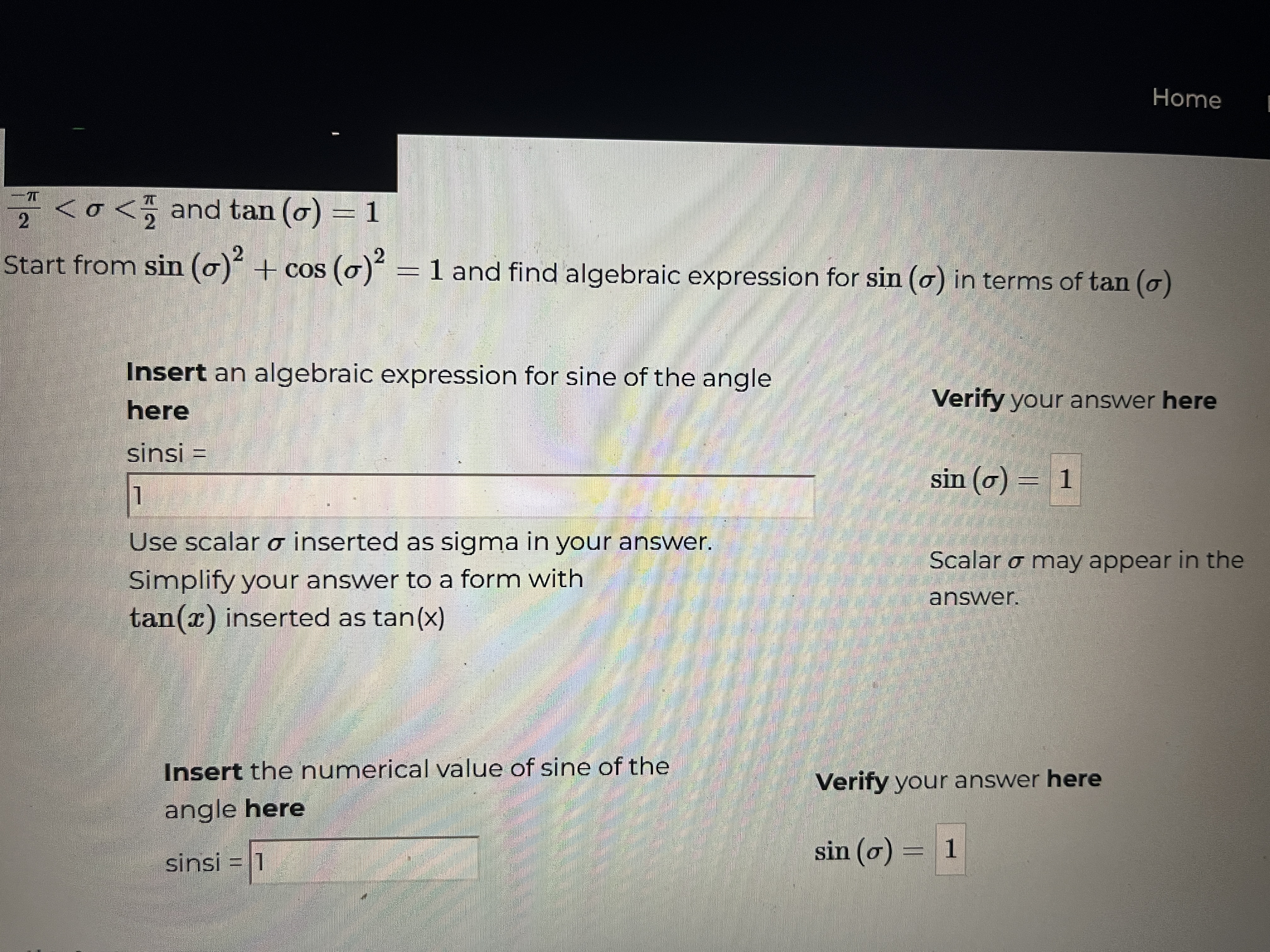Insert an algebraic expression for sine of the angle here and insert the numerical value of sine of the angle here.

Understand the Problem
The question asks to derive an algebraic expression for sin(σ) based on the equation sin(σ)² + cos(σ)² = 1 and given the conditions related to tan(σ). Additionally, it requests to find the numerical value of sin(σ).
Answer
$$\sin(\sigma) = 1$$
Answer for screen readers
The algebraic expression for $\sin(\sigma)$ is: $$ \sin(\sigma) = \tan(\sigma) \cos(\sigma) $$
The numerical value is: $$ \sin(\sigma) = 1 $$
Steps to Solve
- Start with the Pythagorean Identity
The fundamental identity is given by: $$ \sin^2(\sigma) + \cos^2(\sigma) = 1 $$
- Express Cosine in terms of Tangent
We know that: $$ \tan(\sigma) = \frac{\sin(\sigma)}{\cos(\sigma)} $$ From this, we can express cosine: $$ \cos(\sigma) = \frac{\sin(\sigma)}{\tan(\sigma)} $$
- Substitute Cosine into the Identity
Substituting $\cos(\sigma)$ in the Pythagorean identity gives: $$ \sin^2(\sigma) + \left(\frac{\sin(\sigma)}{\tan(\sigma)}\right)^2 = 1 $$
- Simplify the Equation
This can be rewritten as: $$ \sin^2(\sigma) + \frac{\sin^2(\sigma)}{\tan^2(\sigma)} = 1 $$ Let $y = \sin^2(\sigma)$. We then have: $$ y + \frac{y}{\tan^2(\sigma)} = 1 $$
- Combine and Solve for Sin^2(σ)
Multiplying through by $\tan^2(\sigma)$ gives: $$ y \tan^2(\sigma) + y = \tan^2(\sigma)$$ Factoring out $y$: $$ y(\tan^2(\sigma) + 1) = \tan^2(\sigma)$$
- Use the Identity $1 + \tan^2(\sigma) = \sec^2(\sigma)$
This allows us to write: $$ y \sec^2(\sigma) = \tan^2(\sigma)$$ Thus, $$ y = \frac{\tan^2(\sigma)}{\sec^2(\sigma)}$$
- Final Expression for Sin(σ)
Since $y = \sin^2(\sigma)$, we can take the square root: $$ \sin(\sigma) = \sqrt{\frac{\tan^2(\sigma)}{\sec^2(\sigma)}} $$ This simplifies to: $$ \sin(\sigma) = \frac{\tan(\sigma)}{\sec(\sigma)}$$ Using the identity $\sec(\sigma) = \frac{1}{\cos(\sigma)}$, we can write it as: $$ \sin(\sigma) = \tan(\sigma) \cos(\sigma) $$
- Numerical Value of Sin(σ)
Given that $\tan(\sigma) = 1$, in the specified range, we find: $$ \sigma = \frac{\pi}{4} \implies \sin(\sigma) = 1 $$
The algebraic expression for $\sin(\sigma)$ is: $$ \sin(\sigma) = \tan(\sigma) \cos(\sigma) $$
The numerical value is: $$ \sin(\sigma) = 1 $$
More Information
The sine function can be derived from the tangent function using trigonometric identities. At $\sigma = \frac{\pi}{4}$, both sine and cosine equal to $\frac{\sqrt{2}}{2}$, leading to a tangent of 1.
Tips
- Forgetting the Pythagorean identity.
- Incorrectly substituting or manipulating the terms.
- Not recognizing the range of values for σ can lead to misinterpretation of the numerical value.
AI-generated content may contain errors. Please verify critical information